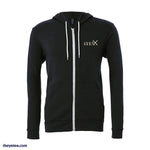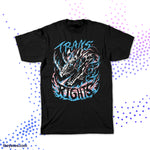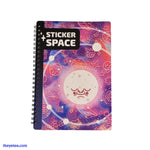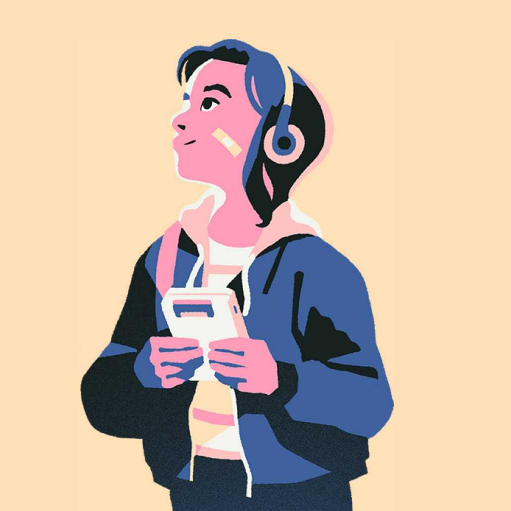An Interview With Thomas Williams composer of Assemble With Care
By Jacob Chase
A warm breeze floats across the water as the taste of salt hanging in the air teases your tongue. Past you, the balmy wind twists and twirls down the catacombs of alleys and avenues in the new port city you’ve just arrived at. The bustling sound of the day’s routine cascades through your ears as the reprise of nature and laughter invites you to stay awhile and let this world carry you on for a little bit…
Assemble With Care is without a doubt one of the best soundtracks I have heard in recent memory. The ambient and eclectic tones that emanate from out of the compositions on this album helps bring life to one of the most complex worlds I have experienced from an ustwo game to date— Because of that, it is fastly becoming a frequent listen of mine during my own routines and audio consumption sessions throughout the week.
As you read along with this article, I invite you to listen with me as I take you through the story of this game, its music, and the composer who wrote it.
Assemble With Care follows the story of Maria, a globe-trotting antique restorer who arrives at the sun-soaked town of Bellariva. Over the course of the game, she helps the inhabitants of this charming city restore their most beloved possessions. Using the tools she brought along with her, Maria reconstructs not only the trinkets of the past but also pieces together the storied and moving memories that these items and their owners have shared.
Over the past couple of weeks, I had the pleasure of sitting down with Assemble With Care’s sound designer and composer Thomas Williams— Join me as I take you on a candid interview and adventure set on taking apart and putting back together the story of Thomas and the music that inhabits this wonderfully charming game:
Jacob Chase: What were some of your biggest influences in you choosing a life in music?
Thomas Williams: I guess music was always a very present part of life growing up as so many of my interests involved music, I loved the roles that music played in films, games, cartoons, and audiobooks. My parents were big influences in piquing my interest in music. There was always music on in the house or the car and my parents often introduced me and my brothers to quite a wide array of new things from classical music to the cheesiest of pop. What was important I think was that they drew our attention to what we were listening to rather than treating it as a passive thing that was just on in the background, we’d talk about the lyrics and different instrument sounds and remember the melodies later in the day.
I was always really inspired by how music accompanied the other mediums I loved. I was always amazed when I felt music drawing me further into a story in a game or film and how it helped me feel something more subtle underlying that would perhaps be being expressed in dialog or setting.
I’d started playing violin in primary school but I felt like music became more of my thing when I discovered guitar playing and composition. My introduction to composition was a little weird but I definitely owe it a lot of inspiration. Back when I was a teenager there seemed to be a trend of cereal packets including CDs of demo software inside. I got one that included this music software called Dance Ejay. It was a compositional tool where you drag across pre-made loops onto a sequencer to arrange into songs. All the sounds were pretty cheesy but as a kid, I think it opened my mind to not think about music just as these finished formed things but as the result of all these different compiled elements and ingredients that could be shifted and re-arranged in many different ways, sort of like musical Lego. I think that helped me realize that I could take it a step further and start to compile my own sounds from the instruments I was learning. My older brother helped me set up some recording software onto the house computer with a microphone and interface and I went from there.
I think probably the biggest inspiration that kept me going learning how to write music and eventually go to study music was just how much joy I got from music and its roles in the mediums I loved. I felt there was just so much magic in things where music would sync up with something, maybe a really beautiful shot in a film or a really poignant moment in a game. So I guess I wanted to be able to in some way get close to offering those moments.
JC: What are some of your favorite games or soundtracks?
TW: My favourite game and soundtrack as a kid was Final Fantasy IX. The soundtrack was able to tell you so much about each of the characters and story and how they evolve, I just loved the sounds of the instruments and the melody writing. I don’t think I knew game soundtracks were a thing then, I was so obsessed with the music in that game that I tried to bootleg a cassette recording from the audio output of the TV so that I could just sit and listen to the music on its own.
In games more recently I found the soundtrack for Everybodys Gone to the Rapture by Jessica Curry incredibly moving. It felt so rewarding to discover the new musical moments as I explored which created such a magical cinematic experience. I love the Monument Valley 2 soundtrack by Todd Baker, which really shifted the thought for me that game soundtracks can also be these stand-alone moving selections of contemporary music.
Outside of games, I’m pretty obsessed with film soundtracks, I’m less into the Hollywood cinematic stuff and prefer smaller weirder ensembles. Stand-outs for me being stuff by Jon Brion, especially Punch Drunk Love and Eternal Sunshine of the Spotless Mind. He seems to be able to wear the different characteristics of genres but still retain his own style. Also loads of the Ghibli films, but again ones with smaller ensembles, and especially the ones that utilize ‘80s /’90s synth weirdness like Only Yesterday, Whisper of the Heart and My Neighbor Totoro.
I also get loads of joy from the Steven Universe soundtracks for their incredible mashups of styles and really interesting arrangements.
JC: How did you create your vision for this album's unique sound?
TW: Me and Dan Gray at ustwo games had a couple of Spotify playlists going back and forth at the start trying to get a sense of the tone of the whole game but also exploring how the characters could be represented through music. This was really useful for inspiration and for us to feel on the same page. I spent quite a lot of time creating concept sketches not thinking too much about where in the game they would be used but more to play with the style and see what the overall musical character of the game could be. It was pretty clear from the beginning that aspects of the score should be reflective of the 1980’s era. I did lots of experimentation with synth and drum sounds, taking inspiration from popular music of the time but it felt that it would be difficult to help support the nuances of the story if the entire soundtrack was just based on 80’s pop hits— It felt like we needed to explore a more subtle cinematic route. I stuck with the pallet of sounds I was working with but started to arrange music that was slower in pace and with richer chords and progressions that could be more evocative and narrative supporting.
Around this time, I became a bit obsessed with this track ‘Real Friends’ by Ariel Pink and Jorje Ehlbrecht. It’s really reflective of those 80’s qualities but draws in stranger dissonant acoustic sounds that give it an otherness. This was quite a big influence in feeling like the music could reflect these 80’s elements but be wrapped up in other elements that add more nuanced qualities and character and ultimately felt a little closer to something new.
I didn’t want the soundtrack to feel pulled straight from the time, I wanted it to be a sort of reminiscent collage, somewhere between pop music, film scores, and TV themes. I also wanted to avoid the music sounding too heavily synthesized and digital, I wanted it to reflect the physical and analog nature of many of the objects being portrayed. Synthesized sounds really helped set the tone and the character of music from the 80’s but I looked to more physical sounds from stringed instruments and metallic percussion. These became the sort of a palette of sounds that I drew from throughout the game. I used things like hand chime cymbals to give the metallic quality, I also used an e-bow on an acoustic guitar quite a lot which gives sort of a rattling string sound. I wanted to feel like rolled in with the digital synthesizers were analog workings of these objects ticking and chiming away.
JC: How much of Assemble With Care did you get to see during your writing process and how was it working so closely with ustwo games on this project?
TW: I had pretty much full access to the game as soon as I started working with the team. I was also working on the project as the sound designer so I wanted to start getting sounds to accompany the interactions in the game as early as I could. I wanted each of the objects to feel really tactile and playful, each like it’s own rhythmic instrument with different timbres. The objects varied a lot so it was important for me that while playing we could hear the different materials and characteristics of each part. I wanted to be able to hear what they were made of, if they were heavy or light, and if they were old and worn. At this stage, I was switching my time between these two processes and begun the music by creating concepts sketches to try to gauge the direction we would take. Coming from a background in film and animation, I feel like I rely on visuals quite a lot to help set me on my way, and considering that lots of the levels were still in white box stage when I joined— I began referring to concept sketches and character designs a lot for inspiration. These were being made by Chris Cox and he was going through varying styles in creating the appearance of the characters and overall visual style of the game, so I always found it really motivating to see these new sketches. I printed lots of the imagery out as we went so by the end of the project my wall was covered with imagery of the project.
Ustwo games were a really great company to work with, everyone was incredibly welcoming and such a kind talented bunch, it was really interesting to see how everyone worked. I’m quite new to the world of games so it was pretty fascinating for me to see the work of each discipline join together. It was a joy to see the game come to life as some new element of the design or interaction, or art and animation made it into the game. To be honest, though I felt a little bit of imposter syndrome at the beginning being quite new to the world of games, and also being such a fan of their previous work.
JC: Assemble With Care is such a visually abstract and moving experience, what were some outlets that you immersed yourself in to help you with the mindset of your writing process for this game?
TW: I spent quite a lot of time with films and pop music of the games time period. We’d spoken quite a lot about soap opera references so I began seeking out what I could learn from TV themes, which was interesting but also a little bit grating. I watched a lot of films from that time too like Neverending Story, Breakfast Club, and went through a phase of discovering quite a lot of J-pop music from that time. I also watched a lot of videos on youtube of objects being taken apart and restored. There seems to be quite a big trend of ASMR videos online honing in on the detailed sounds of certain objects like cassette tapes and old typewriters. This turned out to be the perfect reference because lots of the sound effects are quite hyper-realized, very zoomed in, and exaggerated.
I made sure to surround myself with lots of the artwork being created for the game, whenever Chris would make something new I would print it out and stick it on my wall. It helped a lot because if I was stuck I could just look up and get a prompt from something visual.
JC: What was your favorite restoration project that you got to score for Maria's tinkering adventure?
TW: I really enjoyed working on all the levels, but I think the cassette level has got a particular place of fondness for me because it was one of the first levels I worked on, it was also one of the earliest levels where all aspects like design, tech, and art were completed. That was a big confidence booster I think because it allowed me to really see how everything was working together almost as closely to how a new player would.
I was also a big fan of working on the Projector because it has a really nice narrative shift in the middle at the point where we start to see the family photos. Musically it’s when the sharper edges of Helena’s musical theme start to fall away and her theme becomes warmer. At this point during the level the player advances through the slides of the projector revealing moments from Helena’s past where she was closer to her sister Carmen, I really loved the illustrations on each slide and the way they revealed such a warmth in the sisters’ relationship— so I wanted to make that moment as special as I could. For each slide, I created a musical segment that is triggered in time with the reveal of the illustration, so it only progresses when the player chooses to progress the slides.
Another fun highlight for me was the level with Izzy. It was really fun to create the soundtrack within the Game Boy style console. I’ve never done much chiptune composition so it was fun to do some research around what the original sound restrictions were and to create the music in more of a method way.
JC: What instruments and programs did you use to compose this album?
TW: I work in Logic Pro as my main audio work station where I do all of my composition and mixing. Given that the score is reflective of the time period of the game it felt important to utilize sounds of that era. Most commonly the 1980s was known in pop music for its popularisation of digital synthesizers, notably the Yamaha DX7 I particularly wanted to focus on, it was used everywhere from pop to film scores to TV themes. These days it’s sounds have a particularly cheesy connotation which in part drew me to it even more. I would have loved to have been able to get to work with the real thing but time and money permitting I set out to find which software emulations would work best and to my surprise, there are loads out there which sound great. My particular go to’s were the Arturia DX7, Dexed, and Tal-Uno Juno. With the DX7 lots of music of that time didn’t stray too far away from the preset sounds which lots of these emulations include so at the beginning it was quite easy to find something close. At first It felt tricky to make something feel like my own because lots of these sounds are so distinct and familiar, I didn’t want the music to be a carbon copy of the era, I wanted it to be sort of a hazy re-imaging, a mush of pop music, film and TV scores. So the trick became about layering in other more unusual combinations of sounds. To help reflect the games warm Mediterranean setting brought me to the mandolin and ukulele and acoustic guitar. And also to make the music feel more tactile and physical I added in lots of percussive sounds like chimes and also used an e-bow on an acoustic guitar to create these resonant pitched metallic sounds.
JC: With so many natural elements and sounds woven into the soundtrack’s backdrop, what sort of sampling or experimentation did you do to help bring the music to life in this way?
TW: The original idea for the narrative game aspect was to create something that felt a bit like a radio drama, where you hear the dialog from the characters and get a sense of the location and its surrounding environment. I got really attached to this idea of using the audio to create a sense of place. This in turn affected how I composed the music. I wanted there to be space in the music for you to hear these living environments. This prompted me to make the music more ambient and open and I really loved the way the result blended with these real-world soundscapes to become something new
When it came to making the soundtrack it made me think about why these two worlds needed to be separate when I’d considered them both so important in creating the game. So I started to like the idea that the soundtrack could be an extension to these environments, a way to revisit them, kind of like an audible photo or snapshot of these places. So in the soundtrack, you still hear a medley of different places heard as bird songs, town bells, tram lines, the sound of footsteps on cobbled streets. It all just felt like a nice way to consider the soundtrack as not just something about the music of the game but something about the overall audible picture of the game.
JC: What was your favorite memory from the writing process?
TW: The soundtrack was quite a big dive into new territory for me so some of the best moments came from when the things I was learning paid off, like involving a new instrument or sound. I had a hunch that an E-bow on Acoustic Guitar would be a really cool sound to use because I really liked the way Bon Iver uses it in their records. So I ordered one and once I’d worked out how to play it and record and layer it up I was so happy with the results.
Some of my favourite parts of the process are when a level gets to the point where all the finished elements are in and working together and it starts coming to life, and you get a sense of the experience that the player gets engaging with the game for the first time. I also loved revisiting the material after some time has passed since it was created. In the moment when everything is really busy, it can be tricky to take some time to process and enjoy what your making, this stage can often be overly critical, and when it’s done you’ve spent so much time with that thing you sort of lose touch with whether it’s good or not. It’s great to revisit stuff after a month or so and everything feels like new.
JC: What can people expect next from Thomas Williams?
TW: I’m in the process of creating an album of more personal work, putting this soundtrack together was a big inspiration for me to compile a collection of music, it was the first time I’d put together a big bunch of music I’d worked on and also thought about the flow of each track and how they fit together. I felt like a needed a break from the world of the ’80s to learn some new things. It’s going to be an album of more contemporary ambient pop. I love creating weird instrumental pop tunes so that’s the direction it’s taking at the moment.
I would like to thank Thomas for taking the time to sit down and chat with me about his life, this game, and his work for the purposes of this article.
If you’d like to check out this soundtrack and experience Maria’s story with Thomas’ soundtrack, scope out our product page for the limited edition cassette of this amazing album!
Assemble With Care (Original Soundtrack)

Swing by the Assemble With Care collection now!
Assemble With Care is available as part of Apple Arcade, and is also available on PC through Steam. This is seriously one of the most unique game experiences I have had in some time, and ustwo always has a way with their games that allows me to escape from reality for a bit— and this game is no exception to that fact.
If you’d like to stay up to date with all things Thomas check out his website, as well as his Twitter page for whatever he’s got coming up next!
Keep an eye out on ustwo's website and social media pages to stay up to date on all things Assemble With Care and to follow them on their next artistic voyage in audio and visual storytelling!
Website: https://www.ustwogames.co.uk/










